
| Version | Summary | Created by | Modification | Content Size | Created at | Operation |
|---|---|---|---|---|---|---|
| 1 | mohamed zaifri | -- | 2293 | 2023-08-23 06:17:37 | | | |
| 2 | Lindsay Dong | -2 word(s) | 2291 | 2023-08-24 08:45:38 | | |
Video Upload Options
Augmented reality has emerged as a transformative technology, with the potential to revolutionize the tourism industry.
1. Introduction
2. Research Progress of Augmented Reality in Tourism Industry
2.1. Annual and Regional Distribution of Scientific Production
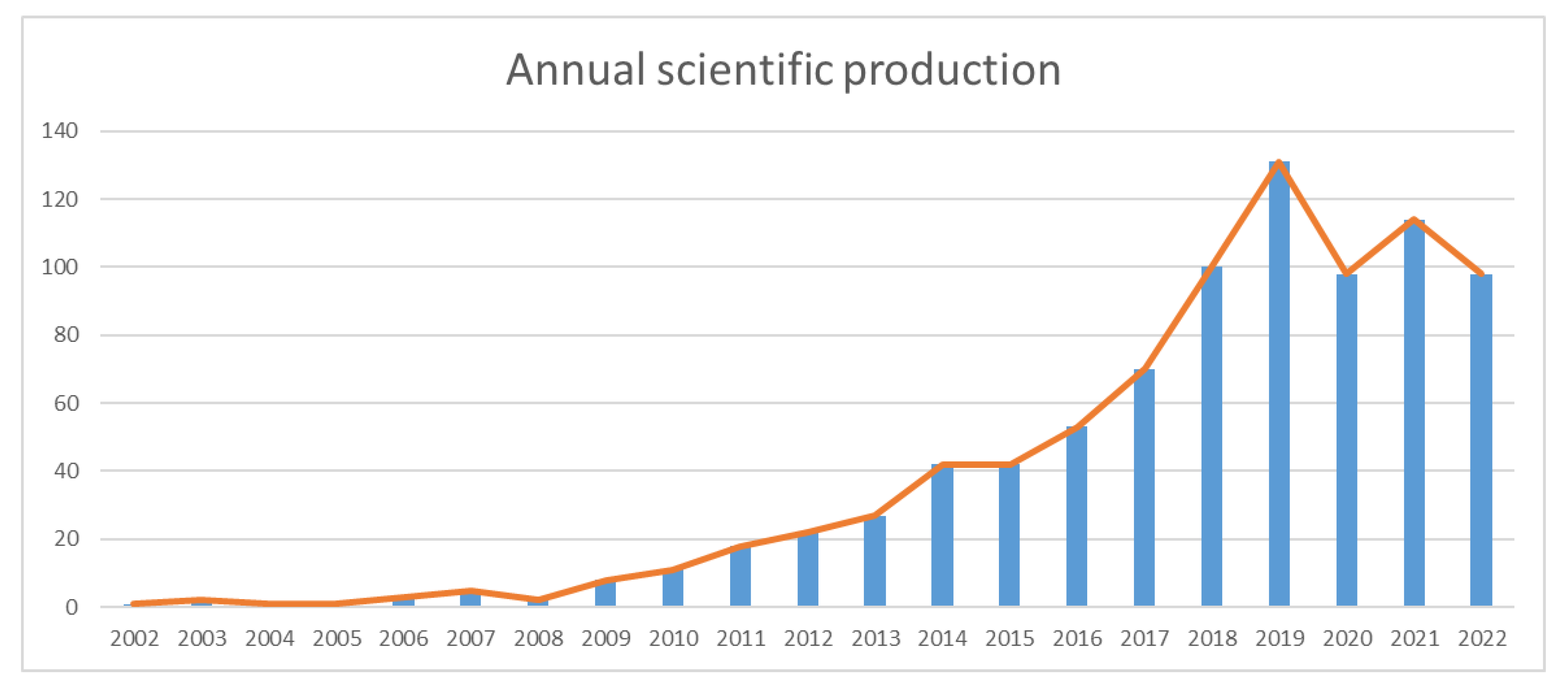
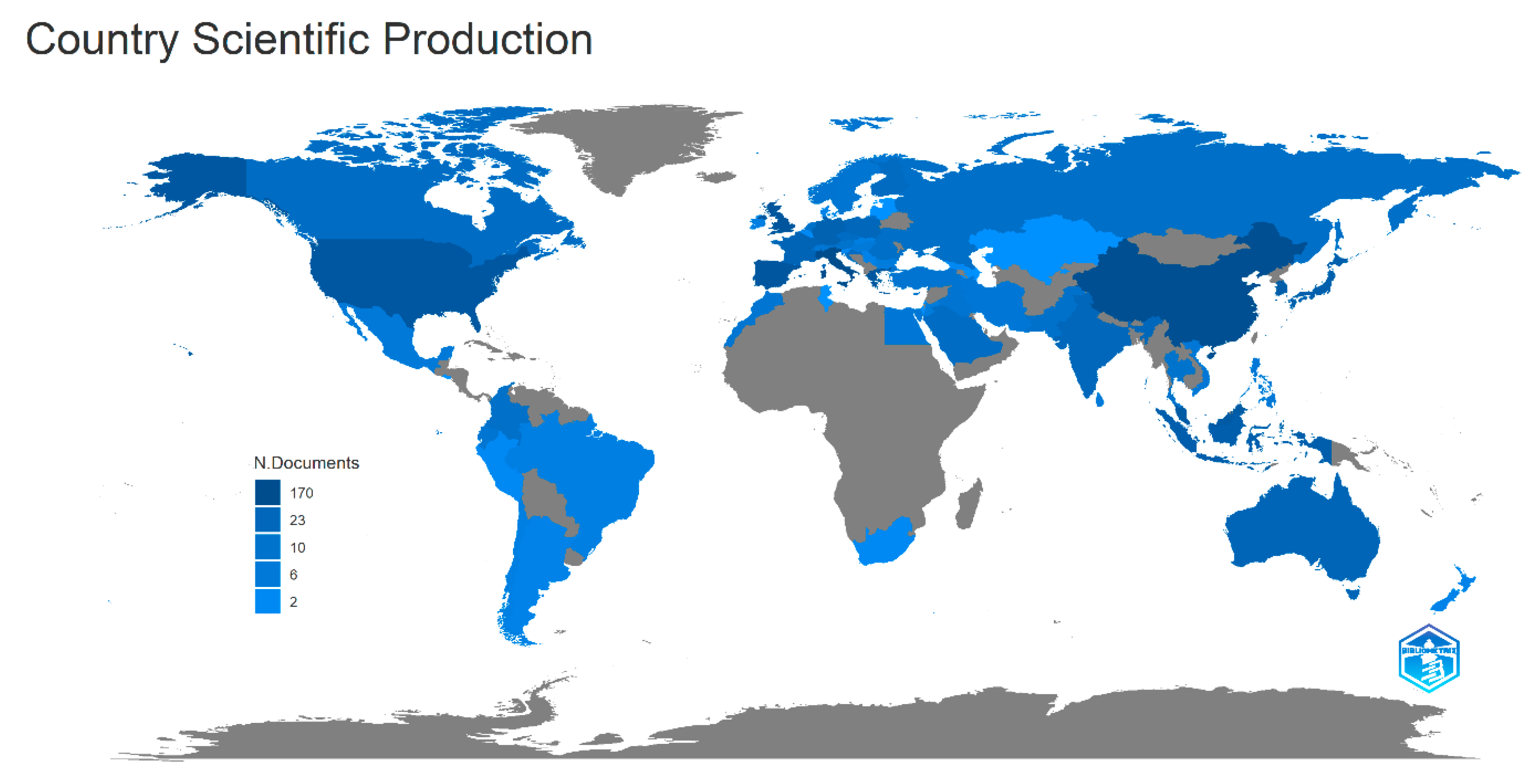

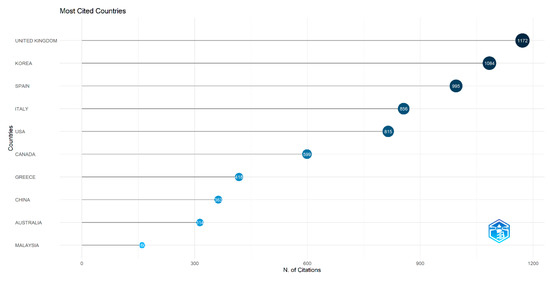
2.2. Emerging Topics of AR in Tourism
Figure 5 provides a network visualization of the conceptual structure of the most commonly occurring concepts in AR research within the tourism industry. Each node in the network diagram represents a specific keyword, while the links between nodes illustrate the frequency of co-occurrence of these keywords. The size of each node corresponds to the frequency of occurrence of the respective keyword, while the thickness of the links represents the strength of the association between the keywords. To facilitate interpretation, each thematic cluster in the network is color-coded, highlighting the most salient topics (nodes) and their interrelationships (links). As a result, a minimum node size was maintained, to ensure visual clarity, regardless of variation in the frequencies of keyword occurrence.
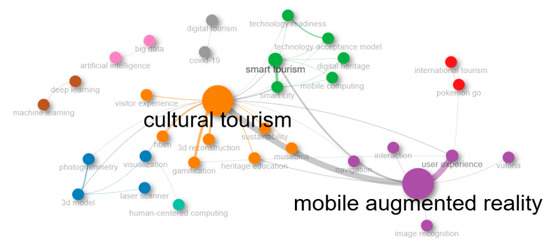
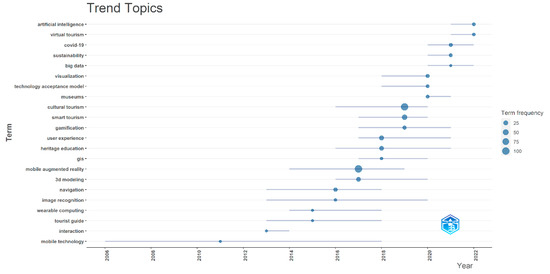
2.3. Most Utilized AR Design Components in Tourism Settings
A content analysis of the 57 articles revealed a variety of AR systems being researched in the context of tourism.
2.3.1. Tracking Systems
As shown in Figure 7a, marker-based systems, which rely on specific visual cues, such as art gallery paintings [23], food menus [24], and museum artifacts [25] for the accurate tracking and rendering of virtual information, account for 18 articles, with 13 focused on image-based systems, and 5 on object-based systems.
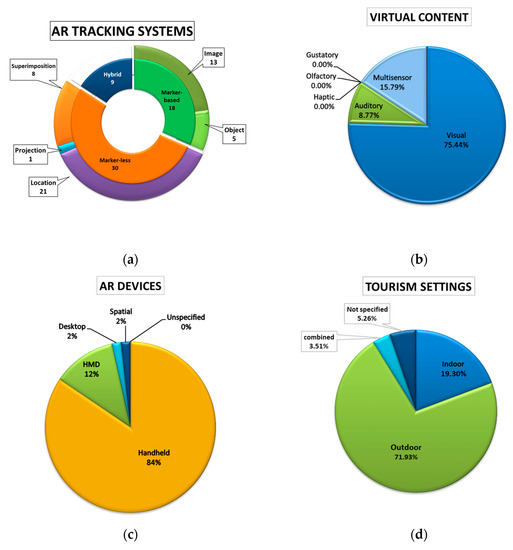
2.3.2. AR Devices
2.3.3. Tourism Settings
2.3.4. Virtual Content
2.3.5. Links between AR Tracking Systems and Tourism Settings
| Indoor | Outdoor | Combined Settings | Not Specified | |
|---|---|---|---|---|
| Marker-based image | 5 [23][29][30][31][32] |
8 [33][34][35][36][37][38][39][40] |
2 [41][42] |
3 [24][43][44] |
| Marker-based object | 1 [25] |
6 [45][46][47][48][49][50] |
1 [41] |
0 |
| Marker-less location | 2 [28][51] |
24 [16][27][38][40][48][52][53][54][55][56][57][58][59][60][61][62][63][64][65][66][67][68][69][70] |
1 [42] |
0 |
| Marker-less projection | 1 [26] |
0 | 0 | 0 |
| Marker-less superimposition | 2 [71][72] |
10 [27][33][45][57][73][74][75][76][77][78] |
0 | 0 |
2.3.6. Links between AR Devices and Virtual Content
| Visual | Auditory | Haptic | Olfactory | Gustatory | Multisensory | |
|---|---|---|---|---|---|---|
| Handheld | 39 [24][27][28][29][30][31][33][34][35][36][39][40][41][43][44][45][46][47][48][49][52][53][54][55][57][59][60][61][63][64][66][67][68][69][70][75][76][77][78] |
2 [16][56] |
0 | 0 | 0 | 8 [25][37][38][42][50][65][73][74] |
| HMD | 3 [23][32][71] |
3 [51][58][62] |
0 | 0 | 0 | 2 [65][72] |
| Desktop | 1 [60] |
0 | 0 | 0 | 0 | 0 |
| Spatial | 1 [26] |
0 | 0 | 0 | 0 | 0 |
The matrix indicates that users are primarily attracted to handheld devices, such as smartphones, tablets, or even portable telescopes, as demonstrated by [60], for creating various types of virtual content. A substantial emphasis is placed on visual (39) and multisensory (8) content.
HMDs, on the other hand, are predominantly utilized for visual content (3), with smart glasses enabling users to interact with 3D animations [71], or enhance learning experiences at art galleries [32]. Similarly, HMDs are employed for auditory content (3), with headsets serving as audio AR tour guides in indoor museums [51] and outdoor environments [58][62]. HMDs have also been used for multisensory content (2), incorporating smart glasses with audio output, to facilitate exploration and navigation of historic sites [65].
Regarding desktop and spatial devices, both have a very limited representation, with each being used only once for generating visual content. This could be attributed to the fact that desktop and spatial devices, such as AR projectors, are less practical, and have limited sensor capacities for AR application in tourism. As a result, researchers and practitioners may be less inclined to explore these devices in the context of AR tourism for enhancing user experiences, instead focusing on more portable and versatile options such as handheld devices and HMDs.
References
- Wei, W. Research progress on virtual reality (VR) and augmented reality (AR) in tourism and hospitality: A critical review of publications from 2000 to 2018. J. Hosp. Tour. Technol. 2019, 10, 539–570.
- Loureiro, S.M.C.; Guerreiro, J.; Ali, F. 20 years of research on virtual reality and augmented reality in tourism context: A text-mining approach. Tour. Manag. 2020, 77, 104028.
- Azuma, R.; Baillot, Y.; Behringer, R.; Feiner, S.; Julier, S.; MacIntyre, B. Recent advances in augmented reality. IEEE Comput. Graph. Appl. 2001, 21, 34–47.
- Liang, L.J.; Elliot, S. A systematic review of augmented reality tourism research: What is now and what is next? Tour. Hosp. Res. 2021, 21, 15–30.
- Vlahakis, V.; Karigiannis, J.; Tsotros, M.; Gounaris, M.; Almeida, L.; Stricker, D.; Gleue, T.; Christou, I.T.; Carlucci, R.; Ioannidis, N. Archeoguide: First results of an augmented reality, mobile computing system in cultural heritage sites. In Proceedings of the 2001 Conference on Virtual Reality, Archeology, and Cultural Heritage, Glyfada, Greece, 28–30 November 2001; Association for Computing Machinery: New York, NY, USA, 2001; pp. 131–140.
- Höllerer, T.; Feiner, S. Mobile augmented reality. Telegeoinformatics Locat.-Based Comput. Serv. 2004, 21, 221–260.
- Kounavis, C.D.; Kasimati, A.E.; Zamani, E.D. Enhancing the tourism experience through mobile augmented reality: Challenges and prospects. Int. J. Eng. Bus. Manag. 2012, 4, 1–6.
- Loureiro, S.M.C.; Nascimento, J. Shaping a view on the influence of technologies on sustainable tourism. Sustainability 2021, 13, 12691.
- Sigala, M. Tourism and COVID-19: Impacts and implications for advancing and resetting industry and research. J. Bus. Res. 2020, 117, 312–321.
- Laine, T.H. Mobile educational augmented reality games: A systematic literature review and two case studies. Computers 2018, 7, 19.
- Mohanty, P.; Hassan, A.; Ekis, E. Augmented reality for relaunching tourism post-COVID-19: Socially distant, virtually connected. Worldw. Hosp. Tour. Themes 2020, 12, 753–760.
- Wolfson, O. Moving objects information management: The database challenge (Vision paper). Next Gener. Inf. Technol. Syst. 2002, 2382, 75–89.
- Hurst, W.; van Wezel, C. Multimodal Interaction Concepts for Mobile Augmented Reality Applications. In Advances in Multimedia Modeling: 17th International Multimedia Modeling Conference, MMM 2011, Taipei, Taiwan, 5–7 January 2011; Proceedings, Part II; Springer: Berlin/Heidelberg, Germany, 2011; Volume 6524, pp. 157–167.
- Mata, F.; Claramunt, C. Augmented navigation in outdoor environments. In Proceedings of the GIS: ACM International Symposium on Advances in Geographic Information Systems, Orlando, FL, USA, 5–8 November 2013; pp. 514–517.
- Laudazi, A.; Boccaccini, R. Augmented museums through mobile apps. In CEUR Workshop Proceedings; Niccolucci, F.R.P., Ed.; CEUR-WS; Association for Computing Machinery: New York, MA, USA, 2014; Volume 1336, pp. 12–17.
- Boletsis, C.; Chasanidou, D. Smart tourism in cities: Exploring urban destinations with audio augmented reality. In ACM International Conference Proceeding Series; Association for Computing Machinery: New York, MA, USA, 2018; pp. 515–521.
- Obeidy, W.K.; Arshad, H.; Huang, J.Y. An acceptance model for smart glasses based tourism augmented reality. In AIP Conference Proceedings; Nifa, F.A.A.L.C.K., Hussain, A., Eds.; American Institute of Physics Inc.: College Park, MD, USA, 2017; Volume 1891.
- Hu, Q.; Yu, D.; Wang, S.; Fu, C.; Ai, M.; Wang, W. Hybrid three-dimensional representation based on panoramic images and three-dimensional models for a virtual museum: Data collection, model, and visualization. Inf. Vis. 2017, 16, 126–138.
- Bermejo, C.; Huang, Z.; Braud, T.; Hui, P. When Augmented Reality meets Big Data. In Proceedings of the 2017 IEEE 37th International Conference on Distributed Computing Systems Workshops (ICDCSW), Atlanta, GA, USA, 5–8 June 2017; pp. 169–174.
- Brozović, D.; Saito, H. The Impacts of Covid-19 on the Tourism Sector: Changes, Adaptations and Challenges. Tour. Int. Interdiscip. J. 2022, 70, 465–479.
- Franco, M.; Mota, L. Reopening for Business Post-COVID-19: Augmented Reality as a Strategy for Attracting Visitors to a Tourist Destination. Eur. J. Tour. Hosp. Recreat. 2021, 11, 54–65.
- Allal-Chérif, O. Intelligent cathedrals: Using augmented reality, virtual reality, and artificial intelligence to provide an intense cultural, historical, and religious visitor experience. Technol. Forecast. Soc. Change 2022, 178, 121604.
- Tom Dieck, M.C.; Jung, T.; Han, D.-I. Mapping requirements for the wearable smart glasses augmented reality museum application. J. Hosp. Tour. Technol. 2016, 7, 230–253.
- Pu, M.; Majid, N.A.A.; Idrus, B. Framework based on mobile augmented reality for translating food menu in thai language to malay language. Int. J. Adv. Sci. Eng. Inf. Technol. 2017, 7, 153–159.
- Rodrigues, J.M.F.; Ramos, C.M.Q.; Pereira, J.A.R.; Sardo, J.D.P.; Cardoso, P.J.S. Mobile Five Senses Augmented Reality System: Technology Acceptance Study. IEEE Access 2019, 7, 163022–163033.
- Mendes, M.; Almeida, J.; Mohamed, H.; Giot, R. Projected augmented reality intelligent model of a city area with path optimization. Algorithms 2019, 12, 140.
- Lipianina-Honcharenko, K.; Savchyshyn, R.; Sachenko, A.; Chaban, A.; Kit, I.; Lendiuk, T. Concept of the Intelligent Guide with AR Support. Int. J. Comput. 2022, 21, 271–277.
- Shin, S.; Choi, Y. SEOUL AR: Designing a mobile AR tour application for seoul sky observatory in South Korea. Electronics 2021, 10, 2552.
- Paliokas, I.; Patenidis, A.T.; Mitsopoulou, E.E.; Tsita, C.; Pehlivanides, G.; Karyati, E.; Tsafaras, S.; Stathopoulos, E.A.; Kokkalas, A.; Diplaris, S.; et al. A gamified augmented reality application for digital heritage and tourism. Appl. Sci. 2020, 10, 7868.
- Agustina, R.; Sutadji, E.; Purnomo; Suprianto, D.; Kusumawati, E.; Hudha, M.N.D.; Afif, M. Analysis of implementation Augmented Reality (AR) introduction of temple and ancient objects based on android to increasing student learning outcomes. In IOP Conference Series: Materials Science and Engineering; Nandiyanto, A.B.D., Abdullah, A.G., Eds.; Institute of Physics Publishing: London, UK, 2018; Volume 434.
- Haryani, P.; Triyono, J. The designing of interactive learning media at Yogyakarta’s sandi museum based on augmented reality. Int. J. Inform. Vis. 2020, 4, 52–57.
- Tom Dieck, M.C.; Jung, T.H.; tom Dieck, D. Enhancing art gallery visitors’ learning experience using wearable augmented reality: Generic learning outcomes perspective. Curr. Issues Tour. 2018, 21, 2014–2034.
- Shih, N.-J.; Diao, P.-H.; Chen, Y. ARTS, an AR tourism system, for the integration of 3D scanning and smartphone AR in cultural heritage tourism and pedagogy. Sensors 2019, 19, 3725.
- Affan, B.N.; Suryanto, A.; Arfriandi, A. Implementation of augmented reality as information and promotion media on Dieng tourism area. Telkomnika Telecommun. Comput. Electron. Control 2018, 16, 1818–1825.
- Besharat, J.; Komninos, A.; Papadimitriou, G.; Lagiou, E.; Garofalakis, J. Augmented paper maps: Design of POI markers and effects on group navigation. J. Ambient Intell. Smart Environ. 2016, 8, 515–530.
- Dewi Agushinta, R.; Hustinawaty; Jatnika, I.; Medyawati, H. Boundary value analysis testing on augmented reality of indonesian fruit recognition at mekarsari tourist park using cloud method on android mobile devices. J. Phys. Conf. Ser. 2019, 1196, 012060.
- Gutierrez, J.M.; Molinero, M.A.; Soto-Martín, O.; Medina, C.R. Augmented Reality Technology Spreads Information about Historical Graffiti in Temple of Debod. Procedia Comput. Sci. 2015, 75, 390–397.
- Han, D.-I.; tom Dieck, M.C.; Jung, T. User experience model for augmented reality applications in urban heritage tourism. J. Herit. Tour. 2018, 13, 46–61.
- Shih, N.-J.; Chen, H.-X.; Chen, T.-Y.; Qiu, Y.-T. Digital preservation and reconstruction of old cultural elements in augmented reality (AR). Sustainability 2020, 12, 9262.
- Tahyudin, I.; Saputra, D.I.S. A response analysis of mobile augmented reality application for Tourism Objects. Int. J. Electr. Comput. Eng. 2017, 7, 3500–3506.
- Amato, A.; Venticinque, S.; Di Martino, B. Image Recognition and Augmented Reality in Cultural Heritage Using OpenCV. In Proceedings of the International Conference on Advances in Mobile Computing & Multimedia—MoMM ’13, Vienna, Austria, 2–4 December 2013; ACM Press: Vienna, Austria, 2013; pp. 53–62.
- Tom Dieck, M.C.; Jung, T. A theoretical model of mobile augmented reality acceptance in urban heritage tourism. Curr. Issues Tour. 2018, 21, 154–174.
- Bibiloni, A.; Ramis, S.; Oliver, A.; Perales, F.J. An Augmented Reality and 360-degree Video System to Access Audiovisual Content through Mobile Devices for Touristic Applications. In Applications and Usability of Interactive TV: 4th Iberoamerican Conference, jAUTI 2015, and 6th Congress on Interactive Digital TV, CTVDI 2015, Palma de Mallorca, Spain, 15–16 October 2015; Springer: Cham, Switzerland, 2016; Volume 605, pp. 44–58.
- Lin, H.-F.; Chen, C.-H. Combining the technology acceptance model and uses and gratifications theory to examine the usage behavior of an augmented reality tour-sharing application. Symmetry 2017, 9, 113.
- Cejka, J.; Mangeruga, M.; Bruno, F.; Skarlatos, D.; Liarokapis, F. Evaluating the Potential of Augmented Reality Interfaces for Exploring Underwater Historical Sites. IEEE Access 2021, 9, 45017–45031.
- Fino, E.R.; Martín-Gutiérrez, J.; Fernández, M.D.M.; Davara, E.A. Interactive tourist guide: Connecting web 2.0, augmented reality and QR codes. Procedia Computer Science 2013, 25, 338–344.
- Li, X.-Z.; Chen, C.-C.; Kang, X.; Kang, J. Research on Relevant Dimensions of Tourism Experience of Intangible Cultural Heritage Lantern Festival: Integrating Generic Learning Outcomes with the Technology Acceptance Model. Front. Psychol. 2022, 13, 943277.
- Sasaki, R.; Yamamoto, K. A sightseeing support system using augmented reality and pictograms within urban tourist areas in Japan. ISPRS Int. J. Geo-Inf. 2019, 8, 381.
- Tatić, D. Mobile Presentation of the War History of the City of Niš. Digit. Present. Preserv. Cult. Sci. Herit. 2022, 12, 151–160.
- Tom Dieck, M.C.; Jung, T.H.; Rauschnabel, P.A. Determining visitor engagement through augmented reality at science festivals: An experience economy perspective. Comput. Hum. Behav. 2018, 82, 44–53.
- Kaghat, F.Z.; Azough, A.; Fakhour, M.; Meknassi, M. A new audio augmented reality interaction and adaptation model for museum visits. Comput. Electr. Eng. 2020, 84, 106606.
- Yovcheva, Z.; Buhalis, D.; Gatzidis, C.; Van Elzakker, C.P.J.M. Empirical evaluation of smartphone Augmented Reality browsers in an urban tourism destination context. Int. J. Mob. Hum. Comput. Interact. 2014, 6, 10–31.
- Basori, A.H.; Abdul Hamid, A.L.B.; Firdausiah Mansur, A.B.; Yusof, N. IMars: Intelligent Municipality Augmented Reality Service for Efficient Information Dissemination based on Deep Learning algorithm in Smart City of Jeddah. Procedia Comput. Sci. 2019, 163, 93–108.
- Abidin, R.Z.; Arshad, H.; Shukri, S.A.A.; Ling, M.F. Leveraging multimodal interaction and adaptive interfaces for location-based augmented reality Islamic tourism application. Int. J. Adv. Sci. Eng. Inf. Technol. 2018, 8, 1784–1791.
- Mendoza, R.; Baldiris, S.; Fabregat, R. Framework to Heritage Education Using Emerging Technologies. Procedia Comput. Sci. 2015, 75, 239–249.
- Chong, U.; Alimardanov, S. Audio Augmented Reality Using Unity for Marine Tourism. In Intelligent Human Computer Interaction; Singh, M., Kang, D.-K., Lee, J.-H., Tiwary, U.S., Singh, D., Chung, W.-Y., Eds.; Springer International Publishing: Cham, Switzerland, 2021; pp. 303–311.
- Panou, C.; Ragia, L.; Dimelli, D.; Mania, K. An architecture for mobile outdoors augmented reality for cultural heritage. ISPRS Int. J. Geo-Inf. 2018, 7, 463.
- Boletsis, C.; Chasanidou, D. Audio augmented reality in public transport for exploring tourist sites. In ACM International Conference Proceedings Series; Association for Computing Machinery: New York, MA, USA, 2018; pp. 721–725.
- Chen, W. Historical Oslo on a handheld device—A mobile augmented reality application. Procedia Comput. Sci. 2014, 35, 979–985.
- Chendeb, S.; Ridene, T.; Leroy, L. A generic augmented reality telescope for heritage valorization. In The International Archives of the Photogrammetry, Remote Sensing and Spatial Information Sciences; International Society for Photogrammetry and Remote Sensing: Istanbul, Turkey, 2013; Volume XL-2/W2, pp. 25–30.
- Demir, O.F.; Karaarslan, E. Augmented reality application for smart tourism: GökovAR. In Proceedings of the 2018 6th International Istanbul Smart Grids and Cities Congress and Fair (ICSG), Istanbul, Turkey, 25–26 April 2018; pp. 164–167.
- Fakhour, M.; Azough, A.; Kaghat, F.-Z.; Meknassi, M. A Cultural Scavenger Hunt Serious Game Based on Audio Augmented Reality. In Advanced Intelligent Systems for Sustainable Development (AI2SD’2019); Ezziyyani, M., Ed.; Advances in Intelligent Systems and Computing; Springer International Publishing: Cham, Switzerland, 2020; Volume 1102, pp. 1–8. ISBN 978-3-030-36652-0.
- Galih, S.; Iansyah, S.; Yudistira, H. Location and orientation based augmented reality mobile application for enhancing heritage landmark history and information. Univ. J. Electr. Electron. Eng. 2019, 6, 39–45.
- Kadi, D.; Suyoto; Santoso, A.J. Mobile application development with augmented reality for promoting tourism objects in Southwest Sumba. In Proceedings of the 2017 3rd International Conference on Science in Information Technology (ICSITech), Bandung, Indonesia, 25–26 October 2017; Riza, L.S., Pranolo, A., Wibawa, A.P., Junaeti, E., Wihardi, Y., Hashim, U.R., Horng, S.-J., Drezewski, R., Lim, H.S., Chakraborty, G., et al., Eds.; Institute of Electrical and Electronics Engineers Inc.: Piscataway, NJ, USA, 2017; Volume 2018, pp. 200–205.
- Litvak, E.; Kuflik, T. Enhancing cultural heritage outdoor experience with augmented-reality smart glasses. Pers. Ubiquitous Comput. 2020, 24, 873–886.
- Rezaee, S.; Sadeghi-Niaraki, A.; Shakeri, M.; Choi, S.-M. Personalized augmented reality based tourism system: Big data and user demographic contexts. Appl. Sci. 2021, 11, 6047.
- Rokhsaritalemi, S.; Sadeghi-Niaraki, A.; Kang, H.-S.; Lee, J.-W.; Choi, S.-M. Ubiquitous Tourist System Based on Multicriteria Decision Making and Augmented Reality. Appl. Sci. 2022, 12, 5241.
- Wegrzyn, M.; Moscicka, A. CityGuideTour Torun—Tourist application using augmented reality. Geod. Cartogr. 2017, 66, 317–331.
- Williams, M.; Yao, K.K.K.; Nurse, J.R.C. ToARist: An augmented reality tourism app created through user-centred design. In Digital Make Believe; BCS Learning and Development Ltd.: Swindon, Wiltshire, 2017; Volume 2017.
- Zaifri, M.; Azough, A.; El Alaoui, S.O. Experimentation of visual augmented reality for visiting the historical monuments of the medina of Fez. In Proceedings of the 2018 International Conference on Intelligent Systems and Computer Vision (ISCV), Fez, Morocco, 2–4 April 2018; IEEE: Piscataway, NJ, USA, 2018; pp. 1–4.
- Bird, J.; Smart, P.; Harris, D.; Phillips, L.; Giannachi, G.; Vine, S. A Magic Leap in Tourism: Intended and Realized Experience of Head-Mounted Augmented Reality in a Museum Context. J. Travel Res. 2022.
- Han, D.-I.D.; tom Dieck, M.C.; Jung, T. Augmented Reality Smart Glasses (ARSG) visitor adoption in cultural tourism. Leis. Stud. 2019, 38, 618–633.
- Marto, A.; Melo, M.; Goncalves, A.; Bessa, M. Development and Evaluation of an Outdoor Multisensory AR System for Cultural Heritage. IEEE Access 2021, 9, 16419–16434.
- Boboc, R.; Duguleana, M.; Voinea, G.; Postelnicu, C.; Popovici, D.; Carrozzino, M. Mobile Augmented Reality for Cultural Heritage: Following the Footsteps of Ovid among Different Locations in Europe. Sustainability 2019, 11, 1167.
- Cibilic, I.; Posloncec-Petric, V.; Tomithc, K. Implementing Augmented Reality in Tourism; Zamperlin, P., Cantile, A., Milli, M., Eds.; University of Zagreb: Zagreb, Croatia, 2021.
- Flores, N.M.; Dolores, L.; Cayabyab, G.; Palaoag, T.; Angeles, J.; Corpuz, G.; Samson, R.; Cruz, J.D.; Mamaril, M. Rebuilding cultural and heritage space of corregidor island using GPS-based augmented reality. Int. J. Recent Technol. Eng. 2019, 8, 2799–2804.
- Huo, X.; Chen, H.; Ma, Y.; Wang, Q. Design and realization of relic augmented reality system of integration positioning and posture sensing technology. In Proceedings of the MATEC Web Conferences, Wuhan, China, 13–14 August 2022; Li, H., Yu, Y., Lei, X., Cai, S., Eds.; EDP Sciences: Les Ulis, France, 2018; Volume 246.
- Messelodi, S.; Modena, C.M.; Porzi, L.; Chippendale, P. i-Street: Detection, Identification, Augmentation of Street Plates in a Touristic Mobile Application. In Image Analysis and Processing—ICIAP 2015 18th International Conference, Genoa, Italy, 7–11 September 2015; Lecture Notes in Computer Science; Murino, V., Puppo, E., Eds.; Springer International Publishing: Cham, Switzerland, 2015; Volume 9280, pp. 194–204. ISBN 978-3-319-23233-1.




